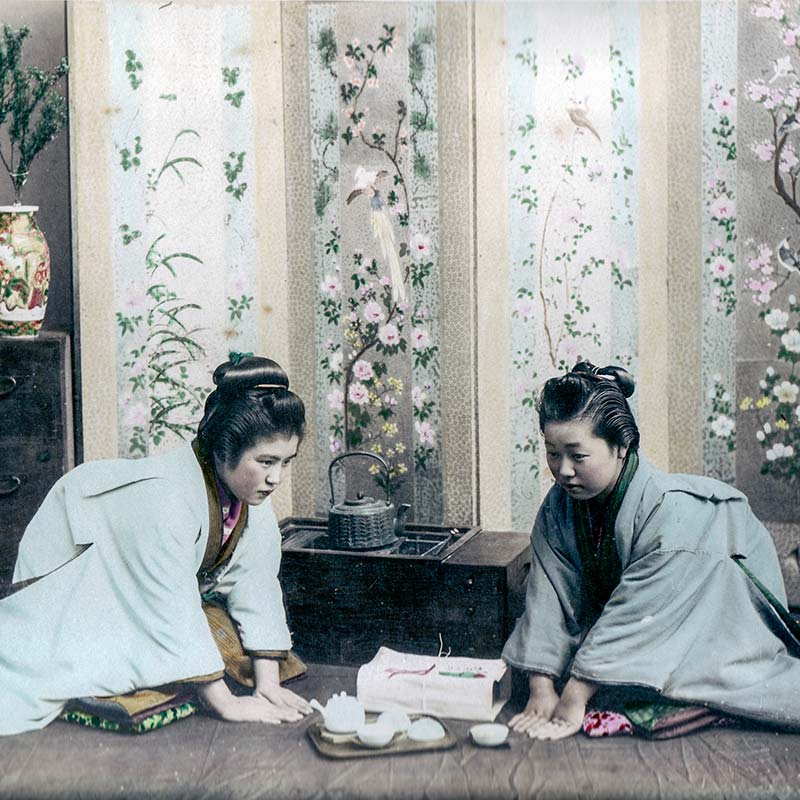A young woman in kimono and traditional Japanese hairstyle looks at a white rose she holds.
This postcard was published sometime between 1907 and 1918. During the early 20th century, picture postcards of bijin (beautiful women) were extremely popular in Japan.
The term bijin has a long history in Japan and is notoriously ambiguous. In a Nov. 6, 2006 UCLA lecture titled “Imperial Beauty: Photographic Truth and the New Spirit of Modern Japanese Aesthetics,” Lippit, a lecturer at the University of Southern California who earned her PhD from Yale, argued that discussions among Japanese artists created an evolution of the word bijin.
Whereas bijin was used to describe either a man or woman during the Edo Period (1603–1867), by the Meiji Period it referred exclusively to beautiful women. A change that paralleled the development of modern Japanese aesthetics.
“The bijin came to characterize modern Japanese aesthetics itself,” said Lippit. “In the latter half of the Meiji, from the 1890’s onward, the figure of the bijin appeared with unprecedented frequency as a graphic representation … in paintings, sculptures, illustrations, posters, postcards, and photographs.”
The word was deeply ambiguous, Lippit argues.
“Bijin [exist] in language, but [are] at the same time inaccessible through language. The term bijin underscores a crisis between language and visuality in addition to the issue of the fundamental ambiguity the term manifests—as a term that in the end cannot be defined.”
In her talk, Lippit also described the reaction of Western critics during the Meiji period to Japanese aesthetics.
“Japanese art, while lauded in many regards for its lacquers, ceramics and such,” she said, “did not, or so it appeared, represent women according to the aesthetics standards of the Western tradition.”
Lippit cited remarks by the first British diplomatic representative in Japan Sir Rutherford Alcock to show that Japanese women were viewed as ugly by Westerners because they were “deformed by Japanese aesthetics.”
“To Westerners, Japanese women were, as it would seem, charming or thought of as artwork,” said Lippit. “But not ‘true’ beauties.”1
This view however was certainly not shared by all Westerners. Many described Japanese women as beautiful in private letters and diaries. For example, in his diary of his thirteen year stay in Japan, Dutch Consul Jonkheer Dirk de Graeff van Polsbroek (1833-1916) repeatedly uses words like “beeldschoon” (rare beauty) and “schoonen” (beauties) to describe Japanese women he met or observed.2
Nowadays, Westerners often compliment the beauty of Japanese women. Several years ago, I met a group of Norwegians on the Shinkansen. One of them told me, “Japanese women are so unbelievably beautiful. Even the ugly ones are beautiful…”
The fact that beauty is notoriously subjective only increases the ambiguity of the word bijin. When Riyo Mori was crowned Miss Universe Japan on 15 March 2007, many Japanese complained that she did not represent true Japanese beauty.
At the same time, current bijin displayed in Japan’s myriad weekly magazines certainly do not remind an observer of the bijin of the Meiji and Taisho periods.
Now once again, Japan’s idea of beauty appears to be undertaking an important transformation. On the one hand, you have the catering to Western ideas of beauty as witnessed by Riyo Mori. On the other, Japanese cosmetics companies are increasingly stressing the beauty of being Japanese.3
Japanese cosmetics giant Shiseido Co., which has long championed the beauty of Japanese women, has recently elevated the beauty of Japanese women to a new level with its Tsubaki. The ads uncharacteristically proclaim that Japanese women are beautiful (日本の女性は美しい). It worked. Tsubaki earned 18 billion yen (USD 155 million or EUR 115 million) in its first year and more companies are now following Shiseido’s lead.4
Notes
1 Lim, Vincent, The Aesthetics of ‘Bijin’. Retrieved on 2008-02-16.
2 Moeshart, Herman J. (1987). Journaal van Jonkheer Dirk de Graeff van Polsbroek. Van Gorcum. ISBN 90-232-2257-1
3 Chalfen, Richard, Beauty Up. Retrieved on 2008-02-16.
4 International Herald Tribune, Shampoo ads highlight changing image of women in Japan. Retrieved on 2008-02-16.
5 JAPANESE STREETS, JAPANESE STREETS. Over 10,000 photos of young Japanese people and models wearing contemporary fashion and make-up.
Published
Updated
Reader Supported
Old Photos of Japan aims to be your personal museum for Japan's visual heritage and to bring the experiences of everyday life in old Japan to you.
To enhance our understanding of Japanese culture and society I track down, acquire, archive, and research images of everyday life, and give them context.
I share what I have found for free on this site, without ads or selling your data.
Your support helps me to continue doing so, and ensures that this exceptional visual heritage will not be lost and forgotten.
Thank you,
Kjeld Duits
Reference for Citations
Duits, Kjeld (). 1910s: Woman with Rose, OLD PHOTOS of JAPAN. Retrieved on December 12, 2025 (GMT) from https://www.oldphotosjapan.com/photos/83/woman-with-rose




min
This website has been incredibly helpful and informative for a basic investigation :) I’ve learned a lot especially with the added comments on the background information of each photograph. Thank you so much!
#000442 ·
Kjeld Duits (Author)
You’re welcome, and thanks for the nice words!
#000443 ·